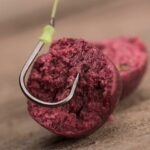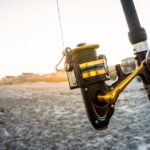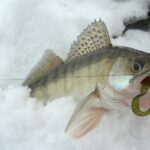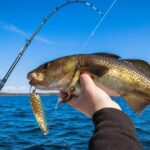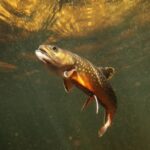When it comes to fishing, the success rate depends on many different factors and conditions. After all, it’s something you’re doing out in the wild, and many things can affect the process.
One of the main factors to consider is the weather conditions as you’re directly exposed to them. And they don’t only affect you but also the fish, which is why you will find different fish during different seasons and temperatures.
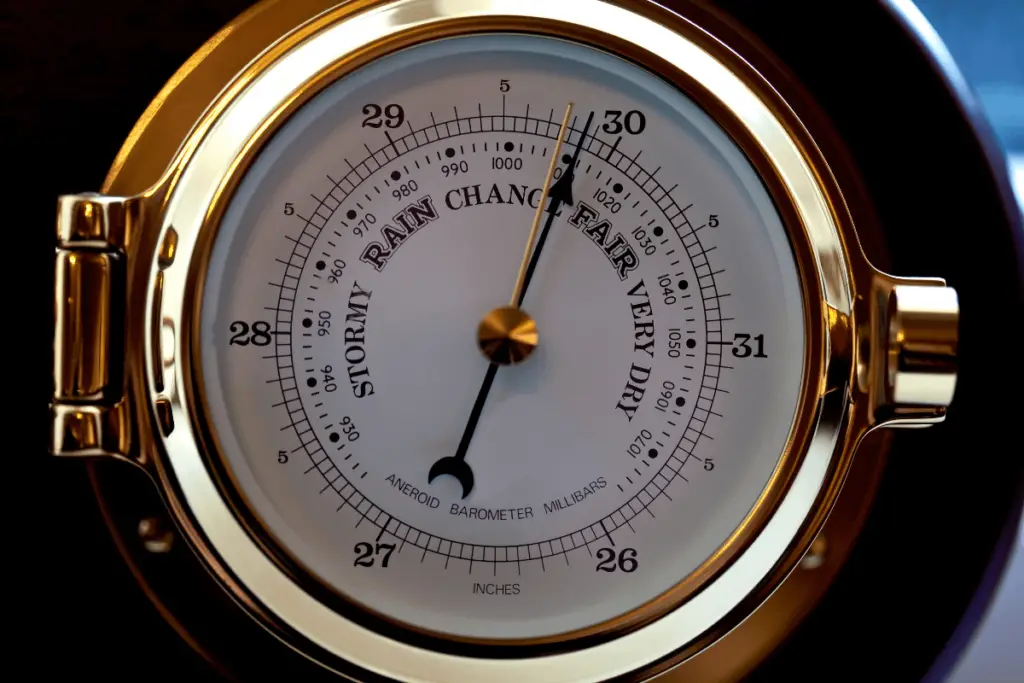
But did you know that with certain weather conditions, a big factor that affects fishing is the barometric pressure?
It can affect the behavior of the fish, as well as the success rate in actually catching them. So, it is definitely something that you should look up along with the weather forecast!
Although…what exactly is the barometric pressure? And how does it affect fishing? And if it affects it that much, then what is the best barometric pressure for fishing?
Don’t worry, we can answer all of these questions and tell you everything you need to know about the ideal barometric pressure for fishing.
Does that sound good? Then let’s get right into it!
What is Barometric Pressure?
Let’s start by clarifying exactly what barometric pressure is, just in case you aren’t sure.
Also known as atmospheric pressure, barometric pressure is essentially the pressure within the atmosphere of the Earth, and it is caused by the weight of the air above a certain point.
So different points on Earth have specific barometric pressures, depending on the amount of air above them.
This is why barometric pressure changes with altitude. The higher up you are, the lower the pressure. This is because of the lesser amount of air you find above you.
And the lower down you are, the higher the pressure. This is because the weight of the air above you increases.
Basically, barometric pressure is caused by the gravitational forces of the planet, which keep the atmosphere in place, and that atmosphere exerts a weight pressure upon the things on Earth.
There are different ways to measure the barometric pressure, depending largely on the country and where in the world you are. But the standard barometric pressure is equivalent to 1013.35 hPa, which is the same as 1013.25 millibars.
This can be a little confusing so the standard barometric pressure is also measured in atmospheres. So 1 atmosphere (1atm) is the standard pressure when you are at sea level. (Although the exact barometric pressure depends on the exact location, the temperature, and many more factors!)
The reason why we associate barometric pressure with the weather conditions is because barometric pressure can change along with the weather. And much like the weather, barometric pressure can affect living organisms, such as fish, and us humans!
You might be wondering how exactly barometric pressure can affect humans, fish, and the act of fishing. So let’s look into that next!
Barometric Pressure and its Effect on Humans
Barometric pressure is a constant force at play within the world. It is something that affects all living organisms on this planet, including humans. And understanding the effect that it has on us can actually be a good way of understanding barometric pressure as a concept, and for what it is.
You may not know it but barometric pressure is something that has likely affected you many times. You just didn’t know it was barometric pressure at work! For example, you know how some days you wake up and you just feel heavy and slow?
Or, you get a headache and have no energy? Well, sometimes the reason for this is barometric pressure!
To explain it a bit better, when we are under the standard barometric pressure there is a specific amount of air above us. That weight has an effect on how our bodies behave in relation to gravity.
So when the pressure, for example, drops, the weight of the air is decreased. This causes our bodies to expand (mainly our body tissue and our blood vessels) and that can cause pain or certain reactions.
There’s a saying that when your body joints hurt, bad weather is on the way. And you might have heard people going on about how there’s a storm coming because they can feel it in their knees. Although this sounds silly and superstitious, there is some science to it that makes it true!
Again, if the pressure drops, this means there is less weight on us and our bodies expand. And the expansion can hurt. Some of your body will fill with air, for example, the sinuses, which can cause really bad headaches. The same goes for your joints.
So if the barometric pressure goes down, which is something that happens when there’s a storm on the way, our bodies don’t feel too great, and it’s what you might otherwise call waking up on the wrong side of the bed. Now you know that it might be down to barometric pressure!
When the pressure is higher, meaning that there is more weight above us, the opposite happens.
Our bodies contract and this can actually cause relief from pain, making you feel better than usual. So if your migraines stop and your joints are suddenly not hurting, it could be because of a higher barometric pressure!
Oh, and a fun fact – older people are a lot more sensitive to changes in barometric pressure. So, listen to grandparents when it comes to predicting the weather!
Although that being said, changes in the barometric weather can sometimes cause some serious health problems (specifically when the barometric pressure drops, giving you those bad days).
But humans aren’t the only ones that can feel the changes of barometric pressure. All other animals can too, including fish! This is why barometric pressure can affect fishing. Let’s jump into that next!
Barometric Pressure and its Effect on Fishing
As we have already mentioned, barometric pressure is a force at play that affects all living organisms on Earth and that includes life underwater, such as fish.
In fact, underwater, you have the weight of the water and the added weight of the atmosphere on top, so the pressure very quickly becomes greater.
The deeper underwater you go, especially in the ocean, the higher the amount of water and air, and so the pressure increases.
In fact, if you go too deep, the pressure can become so high that it ends up crushing you! This is why humans have a limit as to how deep down we can go, as there is a point in which the pressure would completely crush our bodies and…well, kill us.
But back to fish. Most species have air bladders (also known as swim bladders) that fill with air in order to have some buoyancy.
This is what allows fish to basically float and go up or down within the water. Kind of like they are inflating and deflating. Fish then move to the sides by navigating with their fins.
These organs, in charge of filling up with air, are massively affected by barometric pressure because they function with the air, and if the air suddenly weighs less or more, that’s going to have an impact!
If this impact is negative, the fish can change their behavior, along with their feeding patterns, which in turn affects the way that humans are able to fish.
After all, if the fish are suddenly behaving differently, the strategies you have put in place aren’t going to work the same. This sometimes leads to complete failure!
So when the pressure drops, the fish’s bladder will become more inflated, and when the pressure rises, the bladder becomes less inflated.
And this affects how the fish behaves and how the fish is able to swim within the water. Also, this has a bigger effect on smaller fish, as they are more vulnerable to slight changes.
When the pressure drops, it is quite common for fish to swim down into deeper areas of the water, in order to feel better, and be able to swim normally. But, this means they won’t see the bait and you won’t be able to catch them.
Essentially, the barometric pressure directly affects how fish behave and where they swim. This, in turn, indirectly affects your fishing.
Meaning that you absolutely need to take the barometric pressure into account when you are planning a fishing trip and it is something you should check along with the weather conditions.

The Best Barometric Pressure for Fishing
Okay, so we have established what barometric pressure is, as well as how it affects us humans, and how it affects fishing by affecting the fish.
So…what is the best barometric pressure for fishing? As in, what are the ideal barometric conditions in order to have the highest rate of success when fishing? Let’s look into it.
For example, let’s say the barometric pressure rises. Fishing in these conditions will probably be nicer for you, the weather will be nice and it will overall be calm and quiet. But it will actually affect the fish negatively. They will be a lot slower than usual, which might cause them to take the bait a lot less.
So if you do want to fish in these barometric pressure conditions, then you will have to find deeper waters or fish around places where there are plenty of hiding places where the fish might have taken refuge.
So when the barometric pressure is high (above 30.5 inches of mercury), the conditions are great for you and ideal for boat fishing. But, they’re not great for easily finding fish so you will have to search for deeper waters and utilize the tides a lot better.
Basically, it will take a lot more effort, and better-informed strategies, but it will be a great day for you.
When the barometric pressure drops, on the other hand, the weather conditions will be a lot less fun for you but better for the fish. When it is low pressure (less than 29.60 inches of mercury), it is usually windy, gray, and rainy.
The kind of day in which you can tell a storm is brewing. But fish might be faster to bite meaning it will be easier to find them. This is because they will come out of their hiding holes a lot more often.
But then, does that mean that low barometric pressure is the best for fishing?
Not quite.
The best barometric pressure is when the pressure is falling. So right before a storm. This is when fish start to become more active and it is a little before the weather becomes too bad for you. That’s the sweet spot that you should aim for!
If you’re still a bit confused as to what exact barometric pressure you’re supposed to fish in (which we understand, it’s pretty confusing and there’s a lot to look into), then we recommend using a barometric pressure chart specific to fishing.
A barometric pressure chart is essentially just a chart that shows the different kinds of fish activity that you can escape depending on different measurements of barometric pressure.
These are super useful for quickly looking up the barometric pressure that you are expecting so that you know what kind of fish activity you can expect during it.
If you’re looking for a barometric chart that is easy and accessible to beginners, we recommend using the following one:
| High or Low | Barometric Pressure | Fish activity |
| High | 30.5 and over | Fish behave slower |
| Medium | Between 29.70 30.40 | Normal standard fishing activity |
| Low | 29.60 and below | Fish aren’t as active as they could be |
| Rising | Weather that is improving | Fish are slow but becoming activity |
| Stable | Calm and nice weather | Good and standard fishing activity |
| Falling | Weather that is becoming worse | The best fishing activity, fish are active and eager to bite |
There are of course many other barometric pressure charts that you can look up and use, but the one above is fairly simple and is a good guide as to what to expect from the fish in different pressure conditions.
The main thing to remember is that you will get your best fishing done right before a storm when the pressure is falling and the weather is starting to become bad.
How to Track the Barometric Pressure
Now that we’ve established that barometric pressure is a pretty important factor when it comes to fishing, you might want to learn how to keep track of it. Since, you know, having the right barometric pressure conditions can give you a huge advantage, to up your possibilities of success.
But…how do you track barometric pressure? Accurately and reliably, that is. After all, you will usually get information about the barometric pressure during the weather forecast or in the news, but it’s pretty vague, and not exactly useful for those planning a fishing trip.
Instead, you need more detailed barometric pressure tracking with live updates and exact measurements. And the best way to do this is by using an app.
Many different apps can help you track barometric pressure, compatible with all sorts of different devices and technologies. You should absolutely get searching and find an app that works for you, suited to both your personal needs and your preferences.
Often, you can find good barometric pressure tracking systems within fishing apps. These will not only give live updates on the barometric pressure and the weather, but also plenty of tips on locations and the best seasons for catching different types of fish.
The best thing is that with apps, you can often also personalize your settings and preferences, and you could even get alerts for when the optimal barometric pressure conditions are approaching!
Our top favorite app for barometric pressure tracking, specifically for fishing, is the Fishing Forecast App. On this app, you will find live updates that track the barometric pressure at any given location.
It also gives you full weather reports and forecasts. You will also be able to find what species of fish are active in different areas and locations so that you can plan your fishing trip with detailed and advanced information.
And honestly, the app is incredibly reliable and helpful, used by a large community of anglers!
Final Thoughts
To sum it all up, the best barometric pressure for fishing is that of a falling pressure, right before a storm. This is when fish become more active and they will swim up to shallower waters, seeking bait.
However, you need to find an in-between condition between optimal fishing activity and good weather conditions for yourself, so that you can fish comfortably and safely.
- Do You Need An Indicator For Nymph Fishing? - November 16, 2023
- Fishing Safety Tips For Families - September 25, 2023
- What Is The Best Time To Night Fish At A Lake? - September 18, 2023



